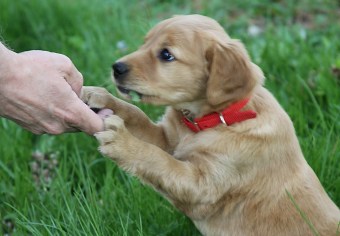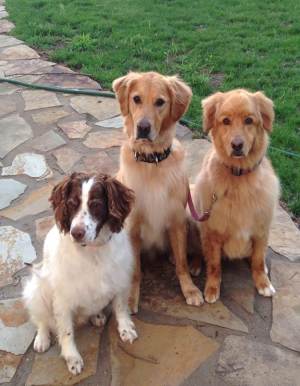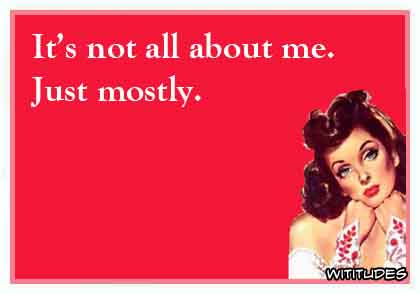We have a new puppy in the house. Alice is her name. She’s cute. Really cute.
Of course, it is possible that I am a bit biased…….(nah…..she really is adorable, even now at 4 months….).
During the first few weeks that Ally was with our family, we could not go walking at our local park without being waylaid by other walkers who would swoop in (often without asking….sigh….) to meet the little puppy, hug the little puppy, and play with the little puppy. These interactions were replete with the high squeaky voice, nonsense words, and scrunched up kissy face that we all know (and sorta don’t love). Ally absorbs all of this attention like the little canine diva she is (though, she says that sometimes she would rather go chasing rabbits).
During these interludes, our three adult boys, Cooper, Chippy and Vinny, quietly offer sit-stays and hope to catch a bit of the fall-out. However, while handsome, friendly, and oh-so-smart, their obvious adult status just does not pull the same emotional heartstrings as Ally’s little puppy face seems to do.
Go ask Alice: So, I asked Alice if she knew why people on the trail swoon over her whilst ignoring her equally wonderful brothers. I thought she would know. She said without hesitation that it is because of her unbearable puppy cuteness (she added that all of the attention does tend to make her feel 10 feet tall).
Puppy narcissism aside, she is quite right. Research tells us so.
We like baby animals: Konrad Lorenz first explained this phenomenon using a concept that he termed “Kindchenschema”. This refers to a set of universal physical attributes of baby mammals that trigger unconscious affiliative (loving) and care-taking responses in adults. These features include large eyes, a proportionately large and domed skull, shortened limbs and overall “pudgy features”. Following Lorenz, the theory that adult humans are naturally drawn to baby mammals has been studied in multiple variants, including with our favorite animal companion, the dog. For example, there is evidence that the infantilism that we see in toy breeds and in dogs with a brachycephalic (smushed nose) facial structure naturally mimic the appearance of puppies and so are highly attractive to many people (1,2). Other baby animal features that we see in some dogs such as floppy ears, pudgy bodies (natural or ahem, acquired), and short legs may be at work creating a canine Kindchenschema as well.
However, despite what Alice thinks, we know that our attraction to dogs is not all about puppies. People are also drawn to adult dogs for a variety of reasons. Two recent research studies have identified a few additional canine attributes that seem to attract us.
We pay attention to color and ears: A study published in 2008 reported that, similar to our tendencies with other people, humans readily assign personality traits to dogs based simply on their appearance (3). However, the study did not attempt to identify specific traits that might influence these perceptions. Recently, Jamie Fratkin and Suzanne Baker at James Madison University in Texas attempted to tease out some of these traits (4). They selected two obvious features that differ among dogs; coat color (yellow vs. black) and ear type (floppy vs. prick). They manipulated the photographs of two dogs to show either a black or yellow coat color on one dog and floppy or prick (pointy) ears in the second dog. Study participants completed a questionnaire that rated each dog in terms of the Big Five personality traits; openness, conscientiousness, extraversion, agreeableness and emotional stability. Results: Both the color of a dog’s coat and the set of a dog’s ears influenced perceptions of personality. Participants perceived dogs with a yellow coat or floppy ears to be more agreeable and emotionally stable when compared to dogs with a black coat or prick ears, respectively. In addition, a dog with a yellow coat was rated higher in conscientiousness than a dog with a black coat and a dog with prick ears was rated as more extraverted than a dog with floppy ears. (Note: the questions that were used to score conscientiousness reflect dependability and self-discipline, which could be interpreted as signifying a dog who is well-behaved and obedient). At its most basic, this set of results tell us that perceptions of a dog’s personality are influenced by coat color and ear type in the absence of other information. More specifically, there is a tendency to perceive yellow dogs who have floppy ears more favorably than black dogs with pointy ears.
It really is (mostly) about us: Julie Hecht and Alexandra Horowitz at City University and Barnard College in New York expanded upon this theme and examined the potential influence that a wide range of physical features in dogs may have upon human perceptions (5). They altered 15 different physical features in each of a series of photographs of 28 adult, mix-breed dogs. Each altered photo was then paired with its original. The targeted features fell into one of four categories: juvenile traits (increased size or spacing of eyes and size of the head), human-like traits (presence of a smile, colored irises), size/symmetry attributes, and a single feature related to domestication (piebald coloring). The changes that they made were subtle enough that people were generally unaware of the difference between the two photographs. Study participants were presented with 80 paired images and were asked to simply select which dog they “liked the best”. Results: The physical traits that most strongly influenced “liking” preferences were the presence of a smile (open mouth, relaxed and retracted commissures) and having colored eye irises. Both of these features occur in human faces and are associated with positive (friendly) emotions. In other words, we tilt towards features that dogs and humans share and that mean similar things. Several, but not all, infantile traits also enhanced a dog’s attractiveness. These included having large eyes, increased spacing between the eyes, and smaller jowls. Conversely, the study found no influencing effects of any other facial features, nor for a dog’s size, symmetry, or presence of piebald coloring.
Take Away for Dog Folks: Taken together, these studies suggest that dog features that naturally attract us include the infantile (puppy) traits of large eyes, domed skulls and floppy ears, as well as yellow coats (when compared with black, anyway). Oh yeah, and we are also attracted to dogs who look similar to friendly people – they smile a lot and their eyes appear friendly and warm. Clearly, years before this research was conducted, Disney knew all of this stuff. One needs only to take a look at Lady from the movie “Lady and the Tramp”, with her large, blue eyes, luxurious yellow coat, pert little (pushed in) puppy nose, and that lovely smile……
Why is this information important? Despite often knowing (or at least being informed of) the much greater importance of a dog’s personality and behavior as the criterion for selecting a pet, many people continue to choose a dog based upon physical appearance. (Ask any experienced shelter worker if you doubt this). People like what they like, and will choose accordingly. And, given the ubiquitous use of web sites and internet services to promote dog adoptions, the first thing that most people see of a dog or puppy who they are considering adopting is a photograph. These studies provide evidence that regardless of trying to convince adopters of the importance of meeting a dog in person, these photographs are an important influencer of adopters’ perceptions (correct or not) of canine personality. Thus shelters, rescue groups, and breeders can use this information not only when determining how to best photograph and present a dog on their websites, but also as they educate potential adopters regarding how a dog’s appearance may be subconsciously influencing them.
As for Alice, she says that white knights and red queens got nothin’ on her being a yellow dog with floppy ears and dark eyes. Seems she is set for life. Gotta go – Time to feed Ally…….
Cited Studies:
- Waller BM, Peirce K, Caeiro C, Scheider L, Burrows AM, McCune S, Kaminski J. Paedomorphic facial expressions give dogs a selective advantage. 2013; PLoS ONE 8(12):e826986.doi:10.1371/journal.pone.0092686.
- Golle J, Lisibach S, Mast FW, Lobmaier JS. Sweet puppies and cute babies: Perceptual adaptation to babyfacedness transfers across species. PLoS ONE 2013;8(3):e58248. doi:10:1371/journal.pone.0058248.
- Kwan VSY, Gosling Sd, John OP. Anthropomorphism as a special case of social perception: A cross-species social relations model analysis of humans and dogs. Social Cognition 2008; 26:129-142.
- Fratkin JL, Baker SC. The role of coat color and ear shape on the perception of personality in dogs. Anthrozoos 2013; 26:125-133.
- Hecht J, Horowitz A. Seeing dogs: Human preferences for dog physical attributes. Anthrozoos 2015; 28:153-163.
P.S. How many of the references to Alice’s namesake song did you catch? Find out here: Jefferson Airplane; White Rabbit







Given your Post title, and the reference to Jefferson Airplane’s “White Rabbit” (Grace Slick doing most of the heavy work!), your Followers would probably be interested in the story of Alice which found its way into the “White Rabbit” song.
LikeLiked by 1 person
I’ll take the Black German Shepherd! I’ve been listing after one for years. I like those uppy ears and clean face and intelligent eyes 🙂
and what’s NOT to love about black dogs?
LikeLiked by 1 person
I love black Shepherds too! And black wolves and black retrievers. Balck dogs have a certain dignity and majesty about them, a regalness that sets them apart from Blondes. In my opinion, blondes just want to have fun. And they are Divas, just like Alice!
LikeLiked by 1 person
Lusting, that is!
LikeLike
I wrote a blog post several years ago (sans scientific evidence…grin) called “Endearing Traits”, suggesting that all of these adorable little puppy traits, while eliciting our maternal instincts, also allow them to get away with murder (with both humans and adult dogs). It has been my experience in the daycare setting that adult dogs will tolerate a lot of inappropriate behavior from puppies and then one day (my observations are at around 5 months old), the free pass has expired. Have you come across any evidence to support that in your research? Perhaps a future Science Dog post?
LikeLiked by 1 person
p.s. Alice is adorable!
p.p.s. Love the song “Go Ask Alice”
LikeLike
I really like what April wrote about but I have a slightly different take on it. I breed collies so have mothers with grown up puppies (the ones I kept from various litters) and lots of aunts, uncles and cousins. My disciplinarians are one of my mother dogs (Valerie) and her son (Elvis) – both of whom are top girl and boy dog receptively in my pack. My other mother dog will put up with lots of bad behavior from her puppies for years, but Aunt Valerie and Uncle Elvis will not. I would be interested in the difference between disciplining puppies by unrelated dogs in a dog daycare setting vs. related dogs who live together in a pack like mine do.
By the way, my mothers know their puppies always – and play with them differently than they do with my other dogs. From what I see, it is a lifelong bond when they have been together continuously since birth. No science behind this – just observation.
LikeLiked by 1 person
I meant respectively.
LikeLike
I love to visit with puppies! I love sending them home with someone else even more 🙂 Not sure where the mixup in my genetic composition is, but I’ve always been the one who talks to the older dog first – then greet the others in descending age order. Of late, it’s the seniors who grab my attention, but that might be because our own brood is entering their golden years.
LikeLiked by 1 person